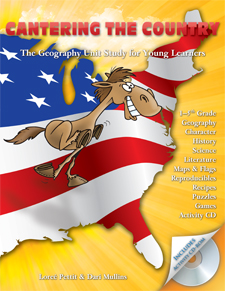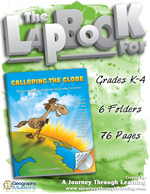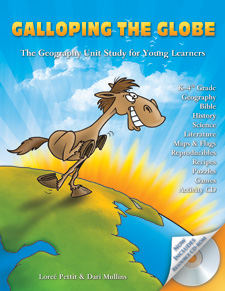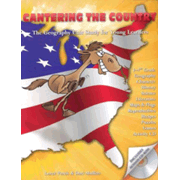Galloping the Globe and Cantering the Country are geography-based unit studies for grammar school students. Galloping the Globe is recommended for children in kindergarten through fourth grade while Cantering the Country slightly shifts the levels up to grades one through five. Either study can be used over a span of from one to three years.
All subjects except math are covered. However, history coverage is not chronological or comprehensive, so you might want to use other resources for children beyond about third grade level. Also, language arts activities are meant to “reinforce grammar and language concepts and provide opportunities for creative writing” rather than provide comprehensive instruction (Galloping, p.4). So you need to provide your own systematic instruction in phonics, grammar, composition, spelling, and handwriting.
Both courses supply you with lots of reading and activity suggestions from which you will choose those that suit your situation.
While core books are recommended, none of them are absolutely required. You can always substitute a book of your choosing or use the internet if appropriate. The library and the internet are likely to supply much of your learning material. Nevertheless, you will probably want to own at least a few of the core books that will be used throughout the study just to make things simpler.
Both unit studies are available with the core book in either print or digital(PDF) format. The books have many activity pages such as maps, data recording forms, puzzles, and patterns. You can photocopy these for your family, but each book includes a CD-ROM at the back with activity sheets and maps that you can print from your computer. Answer keys for activity sheets and puzzles are at the back of each book. All of these same components come as files in the digital versions.
For both courses, students will build their own notebook in a three-ring binder in which they will compile activity and project pages along with other items. You will need to buy a two- or three-inch binder for each child as well as dividers for the various sections of your study.
Galloping the Globe
Galloping the Globe introduces students to the seven continents and selected countries on each continent. While world geography is the primary theme, as students study each continent or country, they learn about famous people (including missionaries), holidays, and animals. While these topics are the primary focus of the course, students also learn about historical events and other science topics, but to a lesser extent. You will need a globe, a children’s atlas, a children's dictionary, and a Bible. A set of encyclopedias is very helpful, although you might access that information on your computer.
Galloping the Globe has suggested scheduling options at the front of the book with general instructions as to what should be accomplished each day. You will likely want to refer to these as you do your lesson planning.
Among the core books for this course are Considering God's Creation, Geography from A to Z, Our Father's World (Rod and Staff second grade social studies text), Children Just Like Me, Big Book of Books and Activities, Usborne Internet-Linked Science Encyclopedia, Magnificent Mammals, Eat Your Way Around the World, and Zoo Guide. These books are used in multiple lessons. Many other books are recommended for individual countries, but you might want to get them from the library if possible.
A general study of the World begins the lessons, then each continent is introduced with one paragraph of information and a map on the facing page on which students will color in the countries that they study. Most attention is upon the individual countries with lesser attention given to the continents as a whole.
Each country study begins with an outline map for students to fill in and a table for students to write in key information they will glean from their resource books. A few paragraphs of information about the country are followed by activities listed under the headings: Geography, History and Biographies, General References, Literature, Language Arts, Science, Activities, Bible, Holidays and Celebrations, and Travel and Tourism.
“Geography” lists terms for children to learn, although some lessons omit the geography category. “History and Biographies” lists titles of books to read that are primarily biographies of famous people related to the country as well as missionaries. Some lessons include audio recommendations, such as the “Mr. Bach Comes to Call” CD (Classical Kids Audio), for studying about Johann Sebastian Bach during the study of Germany. “General References” are books that offer broader coverage of the history and/or culture. For example, a few of the books listed for the study of Spain include Discovering Spain (Leahy), Looking at Spain (Powell), and Spanish Food and Drink (Pellicer). “Literature” selections sometimes overlap history books with biographies, but these are a mix of classic and modern literature that might be more entertaining than historically educational. For example, Favorite Fairy Tales Told in Spain is among the literature for Spain. “Language Arts” generally refers you back to the beginning of the book for a list of suggested language arts activities that can be used with all countries. Occasionally, there will be another suggestion such as that for Mexico: “Make a question and answer book on Volcanoes. Refer to the Big Book of Books and Activities, page 98.” “Science” suggestions might include reading from core books, such as Magnificent Mammals, or using lessons from Considering God's Creation. While many science sections concentrate on animals and their habitats, some veer off into other topics such as the study of volcanoes for Mexico. Occasionally, there will be hands-on activities such as building a birdhouse or coloring a page. “Activities” offer suggestions for coloring, mapwork, musical recordings to listen to, field trips, foods to make (often with recipes from Eat Your Way Around the World but sometimes from included recipes), crafts, or larger projects such as cheese making (for the study of the Netherlands). The “Bible” section lists verses related to lesson topics that can be used for memory work or copy work. “Holidays and Celebrations,” a category that appears only in selected lessons, lists URLs for websites or books such as Festivals of the World: Kenya (Kagda). The “Travel and Tourism” category lists contact information for each country.
I haven't yet mentioned a special lesson that appears about a third of the way into the book, “Christmas Around the World.” This section is obviously best used during the Christmas season. It has the same format as other lessons. However, while it presents Christmas customs from many countries, it skips map work and geography terms. The “History and Biographies” category features only St. Nicholas. Science focuses on deer and reindeer. Activities are all related to Christmas. This is a nice way to keep “school” happening through the holiday season when it's tough to keep children focused on academics
Cantering the Country
 Cantering the Country journeys through the United States, including the District of Columbia. It is very similar to Galloping the Globe as it teaches geography while highlighting the stories of historical figures. Science addresses the trees, flowers, birds, rocks, and minerals for each state as well as other science topics that relate to particular states. These might be wildlife topics, but they also include technology, weather, ecosystems, engineering, and other science-related topics.
Cantering the Country journeys through the United States, including the District of Columbia. It is very similar to Galloping the Globe as it teaches geography while highlighting the stories of historical figures. Science addresses the trees, flowers, birds, rocks, and minerals for each state as well as other science topics that relate to particular states. These might be wildlife topics, but they also include technology, weather, ecosystems, engineering, and other science-related topics.
Categories are similar to those in Galloping the Globe, although “Bible” is replaced by “Character.” Students study character traits reflected in state mottoes and state flag pledges in a humanist fashion rather than with reference to the Bible. Some of the traits covered include patriotism, courage, kindness, inventiveness, discipline, and orderliness.
Lessons are not grouped into units in Cantering the Country, although the instructions suggest a regional grouping that you might use to help students organize their binders into sections.
Core books recommended for this study are Desk Atlas of the U.S., Geography from A to Z, Profiles from History Vol. 1, Eat Your Way through the U.S.A., Earth Science for Every Kid, Zoo Guide, and Aquarium Guide.
While Galloping the Globe is clearly a Christian (Protestant) resource with its Bible verses and missionary stories, Cantering the Country can readily be used by non-religious homeschoolers.
Lapbooks
 A Journey Through Learning has created lapbooks on CD-ROMs for both Galloping the Globe and Cantering the Country. These lapbooks include parallel activities for most of the activity pages in each book plus a few additional items that further enhance the studies. Essentially, you substitute lapbook activities for most of the activity pages in the books. There are 76 pages in the Galloping the Globe Lapbook while there are 91 pages in the lapbook for Cantering the Country. The lapbooks replace the binders, offering a more creative format for students to record and present what they have learned. Lapbooks do not replace the course books. Much of the coursework involves reading from recommended resources, visiting websites, completing other language arts activities, and much more in addition to what takes place in the lapbooks. Still, lapbooks offer a higher level of creativity for students who enjoy constructing them.
A Journey Through Learning has created lapbooks on CD-ROMs for both Galloping the Globe and Cantering the Country. These lapbooks include parallel activities for most of the activity pages in each book plus a few additional items that further enhance the studies. Essentially, you substitute lapbook activities for most of the activity pages in the books. There are 76 pages in the Galloping the Globe Lapbook while there are 91 pages in the lapbook for Cantering the Country. The lapbooks replace the binders, offering a more creative format for students to record and present what they have learned. Lapbooks do not replace the course books. Much of the coursework involves reading from recommended resources, visiting websites, completing other language arts activities, and much more in addition to what takes place in the lapbooks. Still, lapbooks offer a higher level of creativity for students who enjoy constructing them.
Summary
With both Galloping the Globe and Cantering the Country, students might get overwhelmed with a hodgepodge of facts if you try to have them learn all of the information covered within each lesson. On the other hand, if you choose activities selectively, the study can be lively and creative. For example, in Cantering the Country, you could simply read the list of “Interesting Facts” on page 143 that tells us that “Thomas Edison invented electric lights…” and “New Jersey has the highest population density in the United States….” But it would be much more interesting if you read aloud a biography of Thomas Edison (from the recommended list) and then tackled the “Biography Report” like a treasure hunt. The value of these courses is in the multitude of activities from which to select, but your success depends upon selecting wisely to meet your educational goals while paying attention to your children's interests and learning styles.











